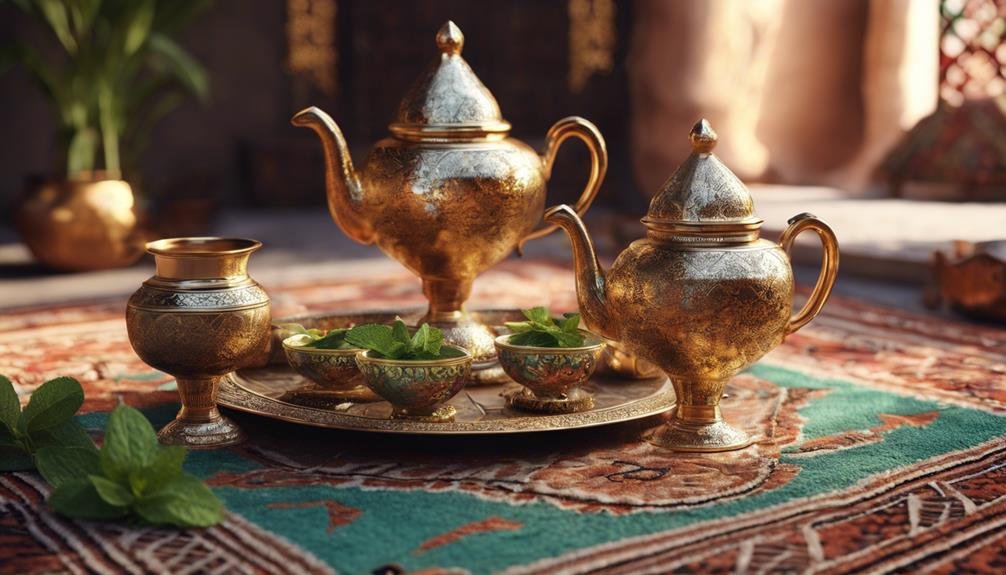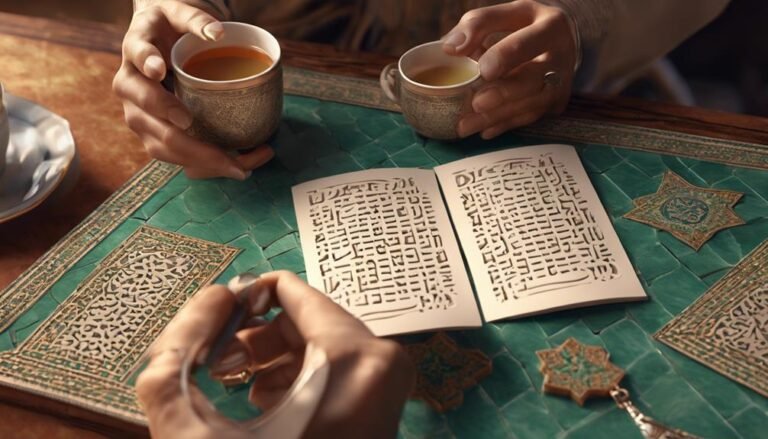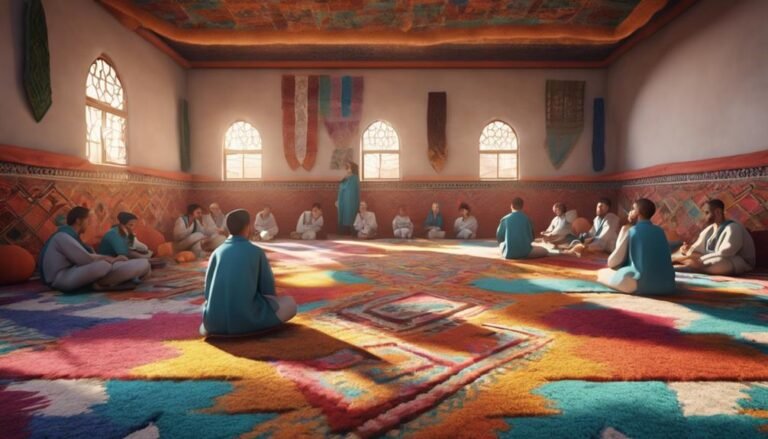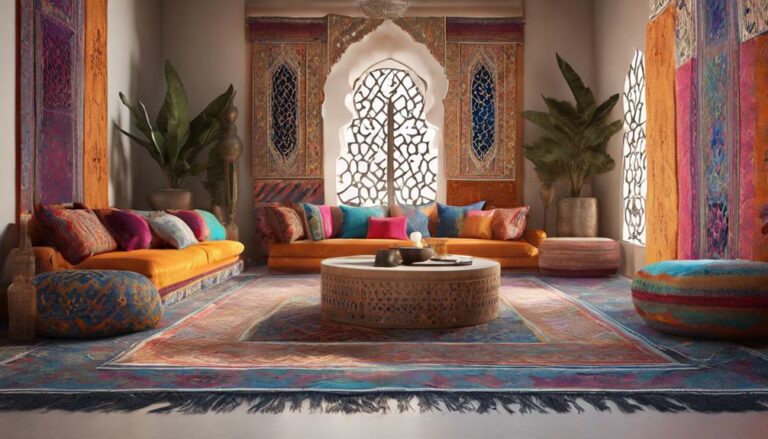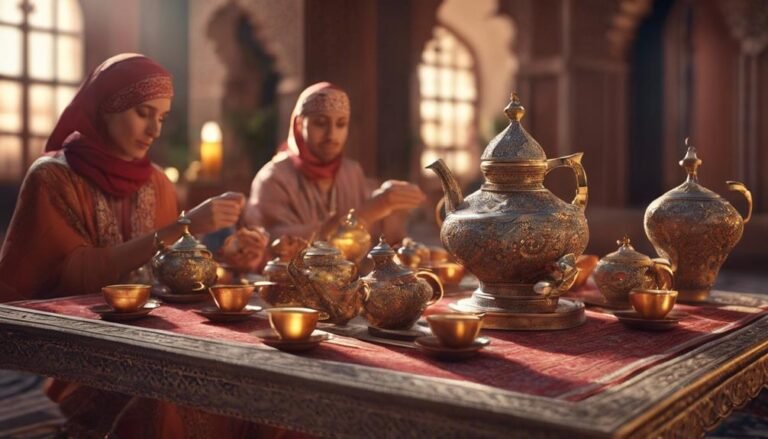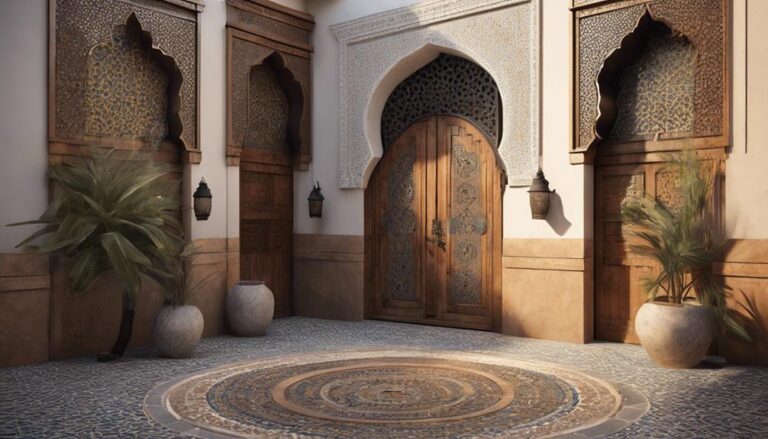Immerse yourself in the rich tapestry of Moroccan tea culture, a tradition steeped in hospitality and history. Influenced by Arab, Berber, and European customs, tea rituals hold a special place in Moroccan social interactions. Delicate blends of green tea, mint, sugar, and water create a symphony of flavors essential to the elaborate brewing process. Traditional ceremonies using specific utensils symbolize purity and warmth. From everyday gatherings to special occasions, tea serves as a centerpiece of Moroccan hospitality, offering a glimpse into the country's vibrant heritage. Explore the nuances of this cherished tradition and savor the essence of Moroccan tea culture.
Key Takeaways
- Moroccan tea culture emphasizes hospitality and tradition.
- Tea rituals blend Arab, Berber, and European customs.
- Origins trace back to trade routes, influencing elaborate ceremonies.
- Essential ingredients include green tea, mint, sugar, and water.
- Serving traditions vary from everyday to special occasions.
History of Moroccan Tea
In the rich tapestry of Moroccan culture, the history of Moroccan tea is a story woven with threads of tradition and trade routes that date back centuries. Moroccan tea holds immense cultural significance, often symbolizing hospitality, friendship, and tradition. The tea rituals in Morocco are deeply ingrained in social customs, where sharing tea is a gesture of warmth and welcome.
Historically, Moroccan tea customs have been influenced by various cultures, including Arab, Berber, and European traditions. The historical origins of Moroccan tea can be traced back to the trade routes that connected Morocco to countries like China, India, and Europe. The blending of these diverse influences has resulted in the unique tea culture seen in Morocco today.
Tea plays a central role in Moroccan social interactions, with elaborate tea ceremonies being a common sight. The preparation and serving of tea are considered an art form, with specific techniques and rituals followed to guarantee a perfect cup of tea. The intricate process of pouring tea from a height to create a frothy top is a well-known Moroccan tea custom that adds to the overall experience of enjoying this beloved beverage.
Ingredients Used in Moroccan Tea
When preparing Moroccan tea, you'll notice the meticulous selection of ingredients plays an essential role. The tea-making process involves a delicate balance of green tea, fresh mint leaves, sugar, and water.
The traditional tea ceremony and the use of specific tea utensils and tools further enhance the rich flavors and aromatic experience.
Tea-Making Process Explained
How do the distinctive ingredients in Moroccan tea contribute to its rich and complex flavor profile?
Moroccan tea brewing involves a unique combination of Chinese gunpowder green tea, fresh mint leaves, and a significant amount of sugar. The gunpowder tea provides a robust and slightly smoky base, while the mint adds a revitalizing and aromatic element. The generous use of sugar not only sweetens the tea but also balances out the bitterness of the green tea.
This blend creates a harmonious fusion of flavors that's both invigorating and soothing. The cultural significance of these ingredients lies in the meticulous preparation process, which involves pouring the tea from a height to create a frothy texture, enhancing the overall experience of enjoying Moroccan tea.
Traditional Tea Ceremony
The traditional Moroccan tea ceremony showcases a harmonious blend of distinctive ingredients that play a pivotal role in creating the rich and complex flavor profile unique to this cultural practice.
Mint, green tea, sugar, and water are the essential components used in Moroccan tea preparation. The meticulous process of brewing tea reflects the traditional rituals and cultural significance attached to this practice.
Mint symbolizes hospitality, green tea signifies purity, and the act of pouring the tea from a height is believed to enhance the taste and create a frothy texture. The balance between the bitter notes of green tea and the sweetness of sugar is a hallmark of Moroccan tea, embodying the cultural values of harmony and balance in every cup.
Tea Utensils and Tools
Tea utensils and tools used in Moroccan tea preparation include a traditional teapot, glasses, a tea tray, and a tea kettle, each serving a specific purpose in the intricate process of brewing this cultural beverage.
- Traditional Teapot: The Moroccan teapot, known as a 'tangia,' is typically ornate and allows for the tea to steep properly.
- Glasses: The small, clear glasses used for serving Moroccan tea showcase the tea's vibrant color and allow for easy pouring.
- Tea Tray: The tea tray is essential for carrying the teapot, glasses, and other accessories during the tea ceremony.
- Tea Kettle: The tea kettle is used to heat the water to the perfect temperature for brewing the tea.
- Mint Sprigs and Sugar Cubes: These items are vital for flavoring the tea and are often added during the brewing process in Moroccan tea ceremonies.
Tea Preparation Rituals
During the traditional Moroccan tea preparation rituals, nuances in the water temperature play a pivotal role in extracting the perfect flavors from the tea leaves. Moroccan tea brewing techniques emphasize the significance of using water that's just below boiling point to guarantee the delicate flavors of the tea are properly extracted without becoming bitter. This contrasts with other cultures where boiling water is commonly used for tea preparation.
Furthermore, Moroccan tea serving etiquette is deeply ingrained in the country's culture. The serving of tea in Morocco isn't just a simple act but a gesture of hospitality and friendship. It's customary for the host to pour the tea from a height, not only to cool it down but also to create a frothy top, adding to the overall experience. This pouring technique is an art form that symbolizes respect for the guests and the importance of the tea ceremony in Moroccan social interactions.
Symbolism of Moroccan Tea
In Moroccan culture, the act of sharing tea transcends mere refreshment, embodying intricate layers of symbolism and social significance. Moroccan tea symbolizes hospitality and friendship, reflecting the warm and welcoming nature of the Moroccan people. It serves as a symbol of tradition and heritage, connecting individuals to their cultural roots and ancestors.
The preparation and serving of tea symbolize respect and generosity towards guests, highlighting the importance of social interactions and relationships in Moroccan society. Moroccan tea also signifies a break from the hustle and bustle of daily life, offering a moment of relaxation and connection with others. Additionally, the sharing of tea symbolizes unity and togetherness, fostering a sense of community and solidarity among individuals.
- Hospitality and Friendship: Tea symbolizes warm hospitality and genuine friendship.
- Tradition and Heritage: It represents the preservation of cultural traditions and ancestral practices.
- Respect and Generosity: The act of serving tea embodies respect and generosity towards guests.
- Relaxation and Connection: Tea provides a moment of relaxation and connection with others.
- Unity and Togetherness: Sharing tea fosters unity and a sense of community among individuals.
Etiquette of Tea Serving
When engaging in the traditional Moroccan tea ceremony, paying attention to subtle gestures and precise movements is essential to embodying the esteemed etiquette of serving this beloved beverage. Tea etiquette in Moroccan culture is a deeply ingrained cultural tradition that reflects hospitality, respect, and tradition. The serving of tea is a ritualistic practice that holds significant importance in social interactions.
In Moroccan tea culture, the act of pouring tea isn't merely about serving a drink but is a symbol of warmth and hospitality. The host is expected to pour the tea with a steady hand and a graceful demeanor, signaling respect to the guests. It's customary for the tea to be poured from a height, not only to mix the flavors but also to demonstrate the host's skill and hospitality.
Moreover, when receiving the tea, it's polite to accept it with both hands as a sign of gratitude. The intricate dance of pouring and serving tea in Morocco is a beautiful display of etiquette that showcases the country's rich cultural heritage.
Variations of Moroccan Mint Tea
When preparing Moroccan mint tea, the steps involved in tea preparation can vary, impacting the flavor and aroma of the final brew. Serving traditions also differ, influencing the overall tea-drinking experience and social interactions.
Additionally, considering the health benefits of Moroccan mint tea adds a layer of complexity to the variations observed in how it's made and enjoyed.
Tea Preparation Steps
For a detailed exploration of Moroccan tea culture, explore the various steps involved in preparing different versions of the beloved Moroccan mint tea. When it comes to tea brewing, Moroccan mint tea stands out for its invigorating taste and aromatic blend.
Here are some variations of Moroccan mint tea preparation:
- Traditional Method: Boiling gunpowder green tea with fresh mint leaves and sugar.
- Modern Twist: Infusing green tea with both fresh mint and spearmint leaves for a more complex flavor.
- Citrus Infusion: Adding a hint of citrus by including orange or lemon peels during brewing.
- Spiced Blend: Incorporating warming spices like cinnamon or ginger for a unique twist.
- Honey Sweetened: Replacing sugar with honey for a different sweetness profile.
Serving Traditions
Moving on from the detailed exploration of Moroccan tea preparation steps, let's now uncover the diverse serving traditions that accompany various versions of Moroccan mint tea. Moroccan mint tea is not just a beverage; it represents a significant aspect of Moroccan culture and hospitality. Tea rituals vary across regions in Morocco, each with its unique serving customs. Below is a comparison table showcasing some common variations in serving traditions:
| Tea Rituals | Serving Customs |
|---|---|
| Everyday Tea | Served in small glasses |
| Special Occasions | Elaborate pouring from a height |
| Hospitality Tea | Three rounds symbolizing life |
| Religious Ceremonies | Served with dates |
These serving traditions add depth and meaning to the act of sharing Moroccan mint tea, making it a cherished part of social interactions in Moroccan culture.
Health Benefits
Investigating the health benefits of different versions of Moroccan mint tea reveals a range of wellness advantages derived from its unique blend of ingredients and preparation methods.
- Rich in Antioxidants: Moroccan mint tea is packed with antioxidants that help combat free radicals in the body.
- Digestive Aid: The combination of mint and green tea can aid in digestion and soothe stomach discomfort.
- Boosts Immunity: The ingredients in Moroccan mint tea, such as green tea and mint, can help boost the immune system.
- Calming Effects: The soothing properties of mint tea can help reduce stress and promote relaxation.
- Hydration: Enjoying Moroccan mint tea can contribute to your daily fluid intake, aiding in overall hydration.
These health benefits, combined with the cultural significance of Moroccan mint tea, make it a popular choice for both wellness and tradition.
Tea Culture in Moroccan Society
Immersing oneself in Moroccan society reveals a rich tapestry of tea culture that intertwines tradition, hospitality, and social connection. Tea rituals hold a deep cultural significance in Moroccan society, serving as a cornerstone of daily life and social interactions. The act of preparing and serving tea is considered an art form, with specific rituals dictating the brewing process, pouring technique, and the number of times the tea is poured.
Tea plays a pivotal role in fostering relationships and nurturing connections between individuals. In Moroccan society, offering tea to guests is a symbol of warmth, generosity, and hospitality. It's a gesture that transcends mere refreshment, signifying respect and care for those being served. The communal aspect of tea drinking promotes togetherness and unity, creating a space for conversation, laughter, and bonding among friends and family.
Comparatively, the tea culture in Moroccan society emphasizes the importance of slowing down, savoring the moment, and cherishing the company of others. It's a practice that values human connection above all else, making tea not just a beverage but a conduit for building meaningful relationships.
Traditional Tea Ceremony
Shifting from the broader context of Moroccan tea culture, the focus now turns to the intricacies and symbolism embedded within the Traditional Tea Ceremony in Moroccan society. The Traditional Tea Ceremony in Morocco isn't merely about drinking tea; it's a ritual that carries deep cultural significance. Here are some key aspects worth noting:
- Tea rituals: The preparation and serving of tea involve specific steps that signify hospitality, respect, and friendship.
- Cultural significance: Tea in Moroccan culture symbolizes hospitality, friendship, and tradition, with each pour representing a gesture of warmth and welcome.
- Use of mint: Adding fresh mint to the tea is a common practice that enhances the flavor and aroma, symbolizing hospitality and friendship.
- Tea pot symbolism: The design and material of the tea pot hold cultural significance, representing tradition and heritage.
- Pouring etiquette: The way tea is poured, high from the pot to the glass, is a gesture of respect and friendship in Moroccan tea ceremonies.
Teas Role in Moroccan Hospitality
Tea plays an integral role in Moroccan hospitality, intricately woven into the fabric of social interactions and cultural traditions. Hospitality customs in Morocco often revolve around the serving of tea to guests, symbolizing warmth, generosity, and friendship. When welcoming visitors into their homes, Moroccans frequently offer mint tea as a gesture of hospitality and respect. The preparation and serving of tea are considered an art form, with each step reflecting the host's attentiveness to their guests' needs.
The cultural significance of tea in Moroccan hospitality extends beyond just a drink; it embodies a sense of community and connection. Sharing tea fosters a bond between individuals, encouraging open communication and camaraderie. The act of pouring tea for others demonstrates care and attentiveness, reinforcing social ties and promoting a welcoming atmosphere.
In comparison to other cultures, Moroccan hospitality customs emphasize the importance of tea as a symbol of friendship and goodwill. The ritual of serving tea to guests reflects the values of hospitality deeply rooted in Moroccan society, showcasing a profound respect for visitors and a desire to create a warm and inviting environment.
Modern Trends in Moroccan Tea
Explore how Moroccan tea culture has adapted to modern trends with the evolution of traditional tea cafes into trendy, modern spaces.
Discover the innovative tea blending techniques that have emerged, blending traditional Moroccan flavors with new, exciting ingredients.
Compare the shift in tea consumption habits in Morocco, from a traditional ritual to a more contemporary and diverse tea experience.
Tea Cafes Evolution
With an increasing number of modern tea cafes popping up in Morocco, the traditional tea culture is undergoing a dynamic transformation in response to contemporary preferences and lifestyles. In these evolving tea cafes, you'll find a blend of tradition and modernity that caters to diverse tastes and interests.
Here are some key trends shaping the evolution of tea cafes in Morocco:
- Fusion of traditional Moroccan tea with global flavors.
- Introduction of innovative tea-based mocktails and cocktails.
- Emphasis on organic and locally sourced tea ingredients.
- Integration of technology for online tea ordering and delivery services.
- Collaboration with local artists and musicians to create unique tea cafe experiences.
Tea Blending Innovations
As the modern tea culture in Morocco continues to evolve, a notable trend that stands out is the innovative approach to tea blending, showcasing a fusion of traditional Moroccan tea with contemporary flavors and techniques. This blending of traditional and modern elements not only adds new dimensions to the flavors of Moroccan tea but also reflects the adaptability and creativity of Moroccan tea culture.
Tea blending techniques have been modernized to include a wider range of ingredients such as fruits, herbs, and spices, creating unique and exciting flavor profiles. These innovations haven't only attracted a younger demographic but have also gained international recognition, further solidifying the cultural significance of Moroccan tea in the global tea market.
Conclusion
To sum up, the Moroccan tea culture is a rich and vibrant tradition that has been passed down through generations. From the intricate tea preparation rituals to the symbolism of hospitality and friendship, Moroccan tea holds a special place in the hearts of its people.
The art of serving tea is a cherished practice that symbolizes unity and connection. So next time you sip on a cup of Moroccan tea, remember that you're partaking in a centuries-old tradition that's as warm and welcoming as a desert oasis.

The Editorial Team is a passionate group of Morocco enthusiasts dedicated to sharing the beauty, culture, and wonders of this captivating country. With diverse backgrounds and a deep love for travel, we strive to bring you engaging and informative content that inspires your Moroccan adventures. From uncovering hidden gems and sharing local insights to exploring mouthwatering cuisine and showcasing the vibrant lifestyle, our team is committed to providing you with valuable resources and exciting stories that enhance your exploration of Morocco. Join us on this journey as we celebrate the rich heritage and unforgettable experiences that make Morocco truly special.

